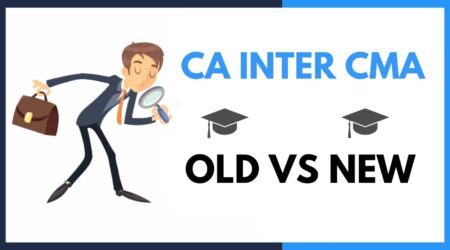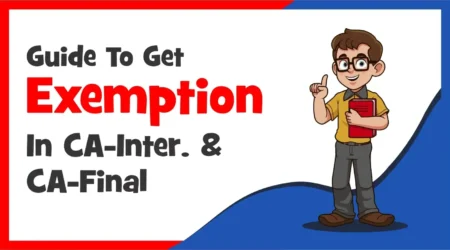Top 7 Chapters to Score 60+ Marks in CA Inter Costing Exam 2026
The CA Intermediate Cost and Management Accounting is a crucial subject of the CA Intermediate curriculum for January, May, and September 2026 exams, requiring conceptual clarity and problem-solving skills.
To score 60+ marks in this subject, it’s essential to focus on the most important chapters of CA Inter Costing that hold a significant weightage in the exams. Here are the top 7 chapters you must practice before exams:
7 Most Important Chapters of CA Inter Costing
1. Cost Sheet
The foundation of costing, the Cost Sheet, is vital for understanding cost structures and classifications. This chapter helps in analyzing various components of total cost, such as prime cost, factory cost, and cost of production. Questions often include preparing comprehensive cost sheets or solving problems based on adjustments for overheads, opening and closing inventories, and abnormal costs.
Why it’s important:
- Easy to understand and score.
- Frequently tested in exams.
2. Activity-Based Costing (ABC)
Activity-Based Costing is a modern approach that focuses on allocating overheads based on activities rather than traditional methods. This chapter deals with identifying cost drivers, activity cost pools, and computing accurate product costs. It often includes case-based questions to test practical understanding.
Why it’s important:
- Regularly appears in both practical and theory questions.
- Provides insights into real-world costing techniques.
3. Process Costing
Process Costing is crucial for industries where production is continuous, such as chemicals or textiles. Key concepts include equivalent units, process losses (normal and abnormal), inter-process profits, and joint costs. This chapter will help you handle step-by-step calculations efficiently.
Why it’s important:
- Frequently tested in numerical form.
- Application-heavy, with real-life relevance.
4. Joint Products and By-Products
This chapter focuses on allocating costs between joint products and by-products, which emerge from a common process. Methods like physical output, sales value at split-off point, and net realizable value are tested here. Understanding these methods thoroughly can help you tackle high-weightage problems.
Why it’s important:
- Often combined with Process Costing questions.
- Tests your ability to handle complex allocation problems.
5. Service Costing
Service Costing, also known as Operating Costing, deals with costing methods for service industries such as transportation, healthcare, and hotels. You’ll often encounter questions requiring the computation of costs per service unit (e.g., per bed, per km).
Why it’s important:
- Straightforward calculations make it easy to score.
- Practical relevance for service-oriented businesses.
6. Standard Costing
This chapter focuses on variance analysis, helping you compare actual costs with standard costs. Variances such as material, labor, overhead, and sales are frequently tested. The ability to interpret variances and provide management insights is a valuable skill.
Why it’s important:
- Numerical-heavy and high-scoring.
- Often tested as standalone questions.
7. Marginal Costing
Marginal Costing is one of the most dynamic chapters in the syllabus. It involves contribution margin, break-even analysis, PV ratio, and decision-making techniques like make-or-buy, product mix, and shutdown decisions. This chapter combines theory and numerical applications, making it indispensable.
Why it’s important:
- Core for managerial decision-making.
- Often appears in case study or practical scenarios.
Read Also: CA Intermediate Exam May 25: Dates, Form Fees, & Timings
Study Tips for Success
- Understand Concepts First: Avoid rote learning. Grasp the “why” behind formulas and techniques.
- Practice Regularly: Solve past exam papers, mock tests, and ICAI study material.
- Focus on Presentation: Neatness and clarity in numerical answers can earn you extra marks.
- Revise Smartly: Prepare summary notes and key formulas for quick revision before the exam.
Complete Syllabus of CA Inter Costing for January 2026 Exams
| Module | Chapters |
|---|---|
| Module 1 | Chapter 1: Introduction to Cost and Management Accounting |
| Chapter 2: Material Cost | |
| Chapter 3: Employee Cost | |
| Chapter 4: Overheads: Absorption Costing Method | |
| Chapter 5: Activity Based Costing | |
| Chapter 6: Cost Sheet | |
| Chapter 7: Cost Accounting System | |
| Module 2 | Chapter 8: Unit & Batch Costing |
| Chapter 9: Job Costing and Contract Costing | |
| Chapter 10: Process & Operation Costing | |
| Chapter 11: Joint Products & By Products | |
| Chapter 12: Service Costing | |
| Chapter 13: Standard Costing | |
| Chapter 14: Marginal Costing | |
| Chapter 15: Budget and Budgetary Control |
Read Also: Single Group Vs Both Groups for CA Intermediate 2026 Exams
FAQs
Do I need to join any classes to learn these chapters of Costing?
Yes, as the CA Intermediate syllabus is entirely new for students attempting the exams for the first time, it is advisable to join classes or access recorded lectures for better understanding. You can consider classes by CA Ashish Kalra, who is one of the best faculties for CA Intermediate in India. He is known for his excellent teaching methods and has a record of students achieving a perfect 100 marks in Costing.
Read Also: CA Intermediate Course Fees May & Sep
How can I revise all the concepts during exam time?
You can use revisionary notes or pocketbooks. Pocketbooks are particularly helpful as they summarize all the key points and topics, making them the most relevant resource for quick revision during exams.
How much time should I allocate for the preparation of CA Inter Costing?
- If you are appearing for the May 2025 exams, dedicate 8–9 hours per day to preparation. (You can check complete CA Inter Group 2 Study Plan for May 2025 Exams Now)
- For the September 2025 exams, you can allocate 4–5 hours daily to balance preparation with other subjects.
Can I score an exemption in the exam by preparing only these 7 chapters?
While these 7 chapters are high-weightage and essential for scoring well, it is important to prepare for all chapters. The CA exam is one of the most challenging exams in India, and there is no guarantee that you will score perfectly on questions solely based on these chapters. A comprehensive preparation covering the entire syllabus is always recommended.
Conclusion
By focusing on these 7 chapters—Cost Sheet, Activity-Based Costing, Process Costing, Joint Products and By-Products, Service Costing, Standard Costing, and Marginal Costing—you can significantly enhance your chances of scoring 60+ marks in the CA Inter Costing paper. These chapters cover the bulk of the exam and provide a balanced mix of theory and practical questions. Consistent practice and a clear understanding of concepts will set you on the path to success.












Leave a Reply